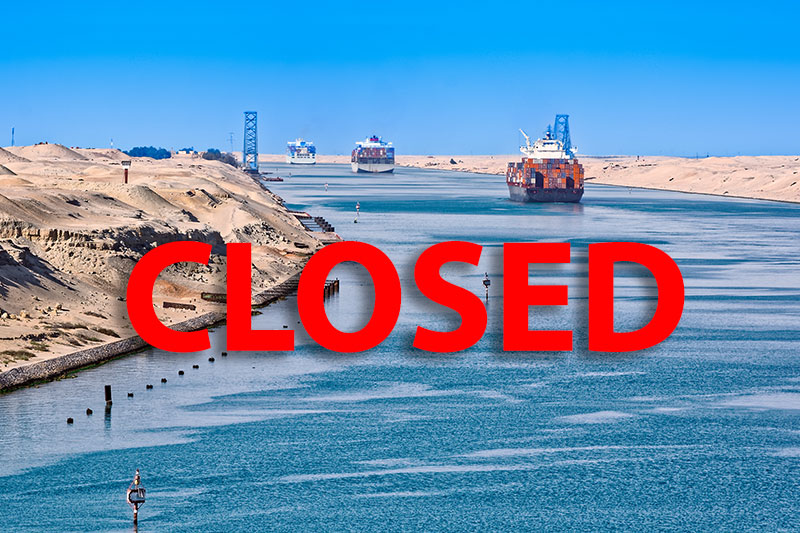Suez Canal travails are the most recent example of supply chain challenges

At a time when the global supply chain is ostensibly dealing with more simultaneous issues than perhaps ever before, including the COVID-19 pandemic, winter weather events, clogged United States Ports, and the need for more labor across myriad parts of the supply chain, it almost feels like this week’s news that the 20,000 TEU (Twenty-Foot Equivalent) vessel Ever Given running aground and trapped in the Suez Canal is just the latest thing to deal with.
That is not said in jest, by any stretch, especially when taking into account that it is not just the Ever Given dealing with this situation. Based on many reports, the actual tally of vessels needing to stay in a holding pattern could actually be in the hundreds, according to an NBC News report.
What’s more, the report explained that clearing up this logjam over one or two days could translate into maybe just a few extra days for goods to be delivered from Asia to the United States, but should the Ever Given stay in place for upwards of a week of more, it could result in an additional 10 days of extra time, with ships rerouted to longer journeys.
This situation further dampens current ocean shipping market conditions, which, over, the course of the pandemic have dealt with tight capacity, escalating rates for shippers, and a container imbalance, among other issues.
Jett McCandless, CEO of Chicago-based project44, called this situation another big blow to an already back-logged and battered supply chain year.
“The Suez Canal supports some 10% of global trade—and now the Ever Given vessel has single-handedly put a stop-block in both directions to that vital trade route between Asia and Europe,” said McCandless. “If they can’t dislodge it with tugs at high tide, they will have to start removing containers to lighten the load and refloat her.”
To put this impact of this situation into even clearer perspective, as of roughly 5 PM ET on March 24, project44 was tracking 34 container vessels, which were either immobilized in the canal, or en route to the zone, representing 379,200 TEUs of capacity. And the company noted that every hour, more vessels, including container ships, oil tankers, RoRo vessels, and bulk carriers, are being backed up in the Mediterranean to the north and the Red Sea to the south.
How long it takes for this situation to be resolved is unclear, at this point. But The New York Times reported that if the Ever Green’s extraction from the Suez Canal goes on, it could have various effects on global trade.
“Global trade has been disrupted as locked-down American consumers ordered vast quantities of factory goods from Asia, yielding a month’s long shortage of shipping containers, the metal boxes that carry parts and finished products around the globe,” the report said. “The blockage of the Suez Canal will affect the movement of things like exercise bikes and printers built in Chinese factories destined for American households, and soybeans grown on American farms and shipped to food processors in Southeast Asia.”
Another pressing theme, or issue, as it relates to this situation, noted Panjiva Research Director Chris Rogers, is the increasing size of vessels like the Ever Green.
“[C]ontainer vessels have become steadily larger over time, with the average tonnage per vessel reaching 119,000 tons in the 12 months to Feb. 28, 2020 from 93,500 in 2015,” Rogers wrote in a research note. “The disaster underscores the myriad physical risks facing supply chains.”
Given the fluidity of this ongoing situation, it is not easy to assess how things may progress. Once again, it shows the heightened importance of the supply chain in so many areas of our everyday lives. LM will continue to provide updates on what happens next.

Article Topics
Latest in Logistics
LM Podcast Series: Assessing the freight transportation and logistics markets with Tom Nightingale, AFS Logistics Investor expectations continue to influence supply chain decision-making The Next Big Steps in Supply Chain Digitalization Under-21 driver pilot program a bust with fleets as FMCSA seeks changes Diesel back over $4 a gallon; Mideast tensions, other worries cited Four U.S. railroads file challenges against FRA’s two-person crew mandate, says report XPO opens up three new services acquired through auction of Yellow’s properties and assets More LogisticsAbout the Author
Subscribe to Logistics Management Magazine

Find out what the world's most innovative companies are doing to improve productivity in their plants and distribution centers.
Start your FREE subscription today.
April 2023 Logistics Management

Latest Resources














